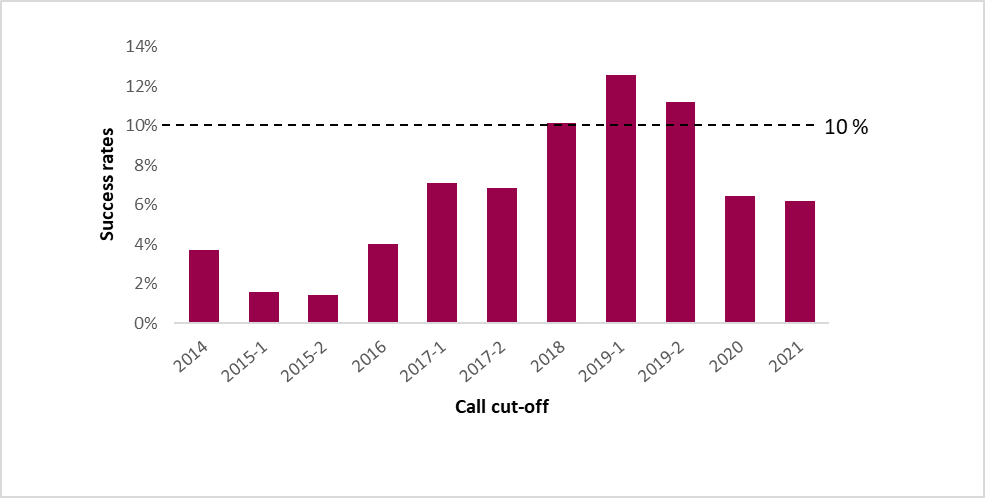Just over 6% success rate in the first EIC Pathfinder Open call under Horizon Europe
26th November 2021 at 9:57 am
The first EIC Pathfinder Open deadline of the Horizon Europe programme attracted a record-breaking number of applications (908) of which 56 high-risk/high gain collaborative projects were selected for funding by the European Innovation Council (EIC). This resulted in a slightly lower success rate (6.17%) than in the last Horizon 2020 call (6.43%) but follows the tradition of what is known as one of the most competitive and prestigious grant schemes in the European funding landscape as shown below.

We are pleased to be involved in one of these projects – CORENET – that aims to develop brain-mimicking computing devices that utilise networks of chemical reactions as molecular information processing systems for future and promising applications in implantable devices, brain-machine interfaces, and personalised medicine. More information is available on our projects page.
The reasons for success are manifold and it is not that straightforward to say what makes the difference. However, in one of our upcoming blog posts, we will share our experience from the first Pathfinder Open proposal submission in 2021. If you are interested in learning from our experience, you are welcome to subscribe to our blog service.
No luck? Try next year!
In case that your proposal has not been selected for funding and you are considering a resubmission, you can do so already for the next EIC Pathfinder Open call that has been provisionally announced for the 2nd March 2022. The EIC Work Programme for 2022 is expected to be published in the coming weeks.
You may also consider the Pathfinder Challenge call with foreseen deadline in October 2022. The main difference between the Pathfinder Open and the Challenge calls is the pre-defined topics for the latter. The last Pathfinder Challenge call focused on five challenges, namely machine learning, novel neurotechnologies, green hydrogen, cell and gene therapy, and engineered living materials.
Contrary to the EIC Accelerator (SME Instrument in Horizon 2020), there are no restrictions when it comes to resubmissions in the EIC Pathfinder. We advise however to carefully assess possibilities of resubmitting, especially in case of a low score in the Excellence. Although the core proposal document is of 17 pages, which is relatively low when compared to standard Horizon Europe proposals, a (re-)submission remains a lot of work. We stay at your disposal if you wish to explore alternative funding opportunities for your research and innovation idea with our Strategic Grant Planning (SGP) service.
From FET to the EIC Pathfinder Open – our track record
Since the introduction of the Future and Emerging Technologies (FET) programme in Horizon 2020, we have supported the preparation of multiple FET proposals, including Lumiblast, Pre-ART, FRINGE, CLASSY and SciFiMed. Our success rate is more than 60% in what is known to be one of the most competitive EU research schemes to date. With many years of proposal writing experience, we can support you throughout your application process and then during the implementation of your Pathfinder Open project. Aside from the soon-to-start CORENET (cheminformatics), we are currently supporting CLASSY (systems chemistry), FRINGE (novel cancer therapy) and macQsimal (quantum metrology and sensing). Our focus areas are in the Health and the Life Sciences, Energy and the Green Deal, as well as several other research and technologies which we have been involved in over the years.
Interested in increasing your chances in this highly competitive scheme? From FET to EIC Pathfinder, our taste for project ideas that are challenging current paradigms stays the same. Have a look at our proposal writing services and contact our EIC Pathfinder experts to discuss how we can best support you with your ambitions.

